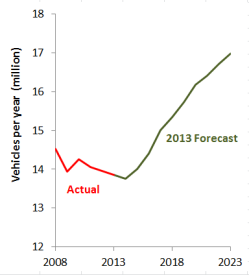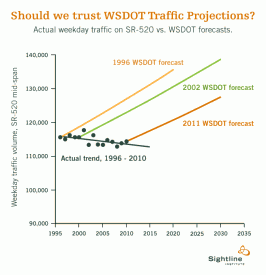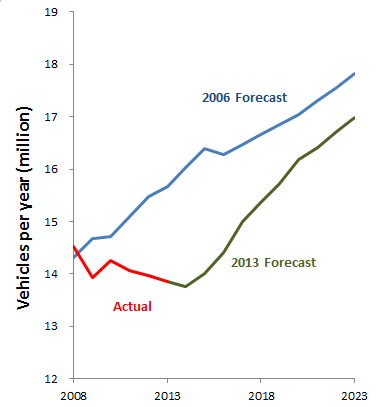For those of you old enough to remember Twin Peaks, I present my suggestion for the ideal spokesperson for the Washington State Transportation Revenue Forecast Council:
OK, now that the shivers have worn off, let me explain.
WSDOT depends on revenue from tolling to pay for some of its construction projects. One notable example is the Tacoma Narrows Bridge: WSDOT added a second, tolled span in 2007, counting on steady growth in traffic volumes to pay for the original construction costs.
 But instead of rising steadily, as originally projected, traffic started tapering off. (See the red line to the right.) At first, transportation planners pinned the declines to the Great Recession of 2009. But after rebounding in 2010, traffic across the bridge has fallen slightly for three consecutive years—confounding policymakers, and forcing a series of controversial rate hikes.
But instead of rising steadily, as originally projected, traffic started tapering off. (See the red line to the right.) At first, transportation planners pinned the declines to the Great Recession of 2009. But after rebounding in 2010, traffic across the bridge has fallen slightly for three consecutive years—confounding policymakers, and forcing a series of controversial rate hikes.
Still, despite higher toll rates that appear to be discouraging additional traffic, state transportation forecasters are once again projecting a prompt increase in traffic—with annual growth rates increasing from 2 percent in 2015 to 4 percent in 2017, before tapering back down to around 1.5 percent in 2022.
So why the creepy Twin Peaks guy? Simple: the new forecasts essentially represent a return to the failed 2006 forecasts, which predicted endless growth in traffic that would quickly pay for the construction costs for the new span:
The creepy Twin Peaks guy is perfectly correct: it is happening again. Without justification, state transportation officials are projecting a rapid increase in traffic volumes that they expect will help solve the problem of underfunded construction projects—despite the fact that there’s essentially no evidence that traffic will suddenly start growing the way it did back in the 1950s. If anything, the new forecast is even more preposterous than the old one, since it predicts faster growth in traffic than the 2006 forecast, despite clear evidence that traffic across the span is at a standstill, or perhaps declining.
The abject failure of “endless growth” traffic forecasts isn’t just an academic issue. It’s actually starting to wreak havoc on transportation budgets all across the Pacific Northwest. Unrealistic traffic growth forecasts pack a double whammy: transportation planners who rely on them feel obligated to accommodate all that new traffic by building massive highway megaprojects; but the failure of the traffic to appear means that there’s just not enough revenue to pay for the overbuilt roads, bridges, and tunnels.
That, in a nutshell, is at the heart of the region’s transportation budget “crisis.” We have built, and are still building, more high-cost road projects than we actually need, even as revenue from gas taxes and tolls just isn’t showing up to pay for it all.

And another thing: to my eye, the Tacoma Narrows Bridge forecast looks very much like the beginning of the state’s bizarre predictions for traffic across the 520 bridge…which for years and years projected that traffic would start growing quickly, even as actual traffic levels stayed roughly flat. Yes indeedy, it is happening again.
Of course, it’s possible that the forecasts could turn out to be correct: even stopped clocks are right every so often. Still, by predicting endless traffic growth, state transportation officials are just making transportation budget woes worse. By forecasting rising revenue that’s unlikely to appear, the “endless growth” forecasts encourage a mentality of “build now, pay later.” For the public, that’s a risky gamble, since it means that future generations will have to keep paying for our bad infrastructure bets today.



Comments are closed.